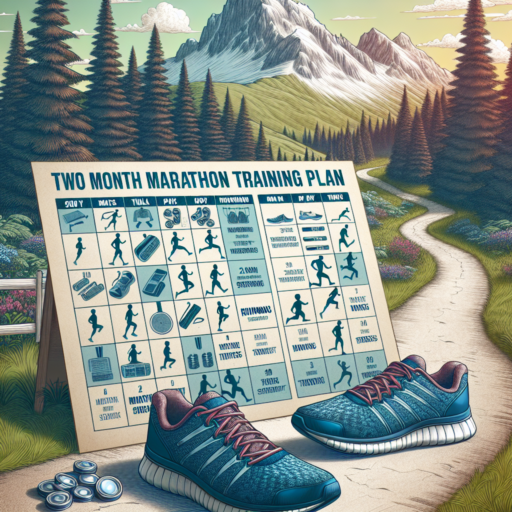Why You Need a Training Guide for Marathon Preparation
Preparing for a marathon is not solely about running longer distances but understanding the intricacies of your body, diet, and the mental game. A well-structured training guide is crucial in navigating the weeks and months leading up to the marathon day. It serves as a roadmap, illustrating not just when and how far to run, but also integrating essential rest days, speed work, and tapering periods necessary for peak performance.
Embarking on a marathon without a training plan is akin to setting off on a long journey without a map. The risk of injury skyrockets as runners might overtrain or neglect the importance of recovery time. A tailored training guide takes into account your current fitness level, goals, and lifestyle commitments, thereby minimizing the risk of common running injuries. Moreover, it ensures that your preparation includes a variety of training types, such as endurance runs, tempo runs, and strength training, which are essential components for a successful marathon finish.
Moreover, mental preparation is an often overlooked aspect of marathon readiness. A comprehensive training guide addresses this by incorporating strategies to boost mental endurance and focus, critical elements for navigating the highs and lows encountered during marathon training and racing. Without the guidance and structured approach provided by a training guide, maintaining motivation and overcoming the psychological challenges of marathon preparation can be significantly harder.
The Ultimate Training Guide for Marathon Beginners
Embarking on your first marathon is a thrilling adventure, one that requires dedication, resilience, and the right guidance. This comprehensive guide is tailored specifically for marathon beginners, ensuring you kick off your journey with confidence. We delve into essential training tips that cover everything from building endurance to injury prevention, making your marathon preparation both effective and enjoyable.
Creating a Solid Training Plan
A well-structured training plan is the backbone of successful marathon preparation. It should gradually increase your mileage, allowing your body to adapt without the risk of injury. Most plans span 16 to 20 weeks, striking a perfect balance between long runs, recovery periods, and varied workouts. Emphasizing consistent progress rather than immediate results is crucial for building the stamina needed for the 26.2 miles.
Importance of Rest and Recovery
Equally important as your running sessions are your rest days. These allow your muscles to heal and grow stronger. Incorporating rest days into your training regimen helps prevent burnout and injuries, which can derail your marathon goals. Embrace activities such as yoga or light stretching, which can aid in recovery and improve your overall flexibility and muscle condition. Remember, rest is not a setback; it’s an integral part of your preparation.
Nutrition and Hydration Strategies
Nutrition and hydration play pivotal roles in your marathon training journey. Adapting your diet to fuel your body with the right balance of carbohydrates, proteins, and fats can significantly enhance your performance and recovery. Staying hydrated is equally important, as dehydration can severely impact your training effectiveness and overall health. Tailoring your nutrition and hydration plans according to your training intensity and personal needs is essential for reaching your peak performance on race day.
How to Customize Your Marathon Training Plan
Customizing your marathon training plan is crucial in catering to your specific goals, fitness level, and lifestyle. Every runner has their own strengths and weaknesses, which means a one-size-fits-all approach rarely works effectively. By tailoring your training regimen, you can focus on areas that need improvement, adjust your schedule based on your availability, and increase your chances of reaching your marathon goals. Understanding the key components necessary for a personalized training plan is the first step towards marathon success.
Identifying Your Running Goals
Setting clear, achievable goals is essential when customizing your marathon training plan. Whether you’re aiming to complete your first marathon, achieve a personal best, or qualify for a major event, your goals will dictate the structure and intensity of your training. For instance, a goal-oriented training plan may require incorporating specific speed work or long runs that align with your target marathon pace. Reflecting on what you aim to achieve will help tailor your training efforts effectively.
Assessing Your Current Fitness Level
Understanding your current physical condition is another critical factor in customizing your marathon plan. It aids in setting realistic training volumes and intensities, preventing overtraining and injuries. An honest assessment includes evaluating your weekly mileage, long run distances, and your comfort with various paces. For beginners, gradually increasing mileage and incorporating rest days is key, whereas more experienced runners might focus on enhancing endurance and speed through more specialized workouts.
Remember, successfully customizing your marathon training plan requires a balance between ambition and realism, considering your unique circumstances and capabilities. This approach ensures not only improvement in performance but also the enjoyment and satisfaction of your marathon journey.
Week-by-Week Marathon Training Schedule Breakdown
Embarking on a marathon journey requires a detailed plan that prepares your body and mind for the ultimate test of endurance. A week-by-week marathon training schedule is crucial for gradually increasing your mileage, strengthening your muscles, and ensuring recovery time to prevent injuries. Starting a marathon training program can seem daunting, but breaking it down into manageable, weekly segments makes the process approachable and achievable.
During the initial weeks, the focus is on building a strong base without overdoing it. It’s essential to start with lower mileage, slowly ramping up the distance as your body adapts. Incorporating rest days and easy runs is as important as the mileage itself to allow for proper recovery. As weeks progress, incorporating variance in training, such as long runs, tempo runs, and speed work, becomes key. These elements work together to improve your aerobic capacity, running economy, and endurance.
As you move closer to marathon day, tapering begins. This period involves reducing mileage and intensity to allow your body to rest and recover before the big day. Proper tapering ensures that you stand on the start line feeling refreshed, healthy, and ready to tackle the 26.2 miles ahead. Additionally, nutrition and hydration strategies should also be refined during this phase, ensuring you’re fueled and hydrated for optimal performance.
No se han encontrado productos.
Marathon Nutrition and Hydration Strategies
Preparing for a marathon involves meticulous attention to nutrition and hydration, crucial companions on your journey to the finish line. The perfect balance of nutrients fuels your body, while effective hydration strategies replace lost fluids, ensuring your performance is optimally sustained from start to finish.
Key Nutritional Components for Marathoners
Understanding the key nutritional components is essential. Carbohydrates stand as the paramount source of energy, necessitating a gradual increase in their intake as race day approaches. Proteins aid in muscle repair and recovery, making them an integral part of a runner’s diet. Fats, though consumed in moderation, provide long-lasting energy reserves. Incorporating a variety of fruits and vegetables can further enhance your diet with vitamins, minerals, and antioxidants, promoting overall health and wellness.
Hydration before, during, and after the Marathon
Hydration strategies cannot be overlooked. Beginning your marathon journey well-hydrated involves starting to increase your fluid intake several days before the event. During the marathon, the goal is to drink at regular intervals, avoiding both dehydration and hyponatremia (low blood sodium level), which can be prevented by including electrolyte-enhanced drinks in your hydration plan. Post-marathon, replenishing fluids is just as important, focusing on electrolyte and water balance restoration to support recovery.
Necessary Gear and Tools for Marathon Training
When embarking on marathon training, equipping yourself with the right gear and tools is crucial for both your performance and injury prevention. Key items ensure comfort, enable precise tracking of progress, and help in achieving your marathon goals. Whether you’re a novice runner or an experienced marathoner, the essentials remain universal.
Footwear Essentials for Long-Distance Running
At the core of marathon training gear is the right pair of running shoes. Choosing footwear designed for your specific foot type and gait can significantly reduce the risk of injuries. Running shoes with adequate cushioning and support are paramount. It’s also advisable to consider the terrain you’ll be training on—road running shoes differ vastly from trail running options. Additionally, investing in quality running socks can prevent blisters and enhance comfort.
Performance Tracking Tools
To monitor your progress effectively, incorporating technology into your training is beneficial. A reliable running watch or a fitness tracker that measures pace, distance, heart rate, and calories burned is indispensable. These devices not only track your daily activity but also help in setting and refining training goals. For those focused on detailed metrics, GPS watches offer insights into running form, cadence, and elevation changes.
Hydration and Nutrition Support
Maintaining adequate hydration and nutrition during long runs is essential. A well-designed running belt or hydration pack allows easy access to water and energy gels, ensuring you stay fueled and hydrated without breaking your stride. For training sessions extending beyond an hour, especially in warm weather, this gear becomes indispensable in preventing dehydration and energy depletion.
Cross-Training and Recovery Techniques for Marathon Runners
Para abordar eficazmente el tema del entrenamiento cruzado y las técnicas de recuperación para corredores de maratón, es importante comenzar por entender cómo estas prácticas complementan una rutina de entrenamiento intensivo dirigida a la resistencia de larga distancia. La inclusión de diferentes tipos de ejercicios en el proceso de entrenamiento no solo ayuda a prevenir lesiones, sino que también permite que los músculos se recuperen apropiadamente, mejorando así el rendimiento general del corredor.
Técnicas de Entrenamiento Cruzado Para Corredores de Maratón
El entrenamiento cruzado involucra la participación en actividades físicas fuera de la carrera, permitiendo que ciertos grupos musculares descansen mientras otros trabajan. Actividades como natación, ciclismo, y los ejercicios de fortalecimiento del core son algunos ejemplos efectivos que complementan perfectamente el entrenamiento para maratón. Estos ejercicios no solo ayudan a mejorar la resistencia cardiovascular sin el estrés adicional en las piernas, sino que además contribuyen a fortalecer músculos que no se utilizan tanto al correr.
Métodos de Recuperación Después de un Maratón
Una vez cruzada la línea de meta, la recuperación debe comenzar de inmediato para asegurar una pronta recuperación musculoesquelética. Técnicas efectivas incluyen el uso de crioterapia (baños de hielo), compresión, y ejercicios de movilidad y estiramientos enfocados en la regeneración de los tejidos musculares. Además, la hidratación y el uso estratégico de nutrición post-carrera son fundamentales para reemplazar líquidos perdidos y nutrientes esenciales, respaldando así el proceso de recuperación.
Incorporar actividades de bajo impacto como la yoga y el Pilates unas semanas después del día de la carrera puede fomentar la recuperación muscular y la flexibilidad, mientras que simultáneamente mejora la alineación corporal y el balance. Esta diversificación en el entrenamiento ayuda no solo a revitalizar el cuerpo, sino también a mantener la motivación alta, al introducir variedad en la rutina. Cada técnica de recuperación y entrenamiento cruzado tiene como fin preparar al corredor tanto física como mentalmente para futuras maratones, optimizando su rendimiento y bienestar en el largo plazo.
Common Marathon Training Mistakes to Avoid
Training for a marathon is an endeavor that requires commitment, perseverance, and a strategic approach. While aspiring marathoners put in a great deal of effort to prepare for the race, certain common mistakes can significantly hamper their progress and overall performance. Recognizing and avoiding these pitfalls is crucial to ensure a successful and injury-free marathon experience.
Ignoring Rest Days
One of the most critical mistakes runners often make is skipping rest days. Rest is integral to the body’s recovery process, allowing muscles to repair and strengthen. Neglecting proper rest can lead to overuse injuries, burnout, and decreased performance. Ensuring adequate rest is incorporated into your training regimen is essential for peak performance on race day.
Overlooking Nutrition and Hydration
Nutrition and hydration are pivotal elements of an effective marathon training program. Many runners fail to adapt their diet and fluid intake to meet the increased demands of training. Consuming a balanced diet rich in carbohydrates, proteins, and healthy fats, along with staying well-hydrated, supports endurance and recovery. Ignoring these aspects can impair performance and health.
Another common oversight is the lack of a structured training plan. Without a clear plan, runners risk not only undertraining but also overtraining, which can lead to fatigue, injuries, and not meeting personal goals. A well-structured plan, tailored to an individual’s fitness level and marathon goals, lays a concrete path towards success. Proper planning ensures a balanced mix of run types, distances, and recovery periods, paving the way for an optimized marathon performance.
Mental Preparation Tips for Your First Marathon
Preparing mentally for your first marathon can be just as crucial as physical training. A positive mindset can help carry you across the finish line. Here are a few mental preparation tips that can set you up for success.
First and foremost, visualize your success. Visualization is a powerful tool used by athletes worldwide. Spend time each day leading up to the race visualizing crossing the finish line. Imagine the crowds cheering, the feeling of accomplishment, and even the fatigue in your legs. This practice can help reinforce your internal motivation and make the goal seem more attainable.
Another essential step is to set realistic goals. When tackling your first marathon, it’s critical to set goals that are achievable. Whether it’s to simply finish the race, achieve a specific time, or just enjoy the experience without pressure, setting clear, realistic goals can help manage expectations and reduce pre-race anxiety.
Embrace Positive Self-Talk
Finally, embrace the power of positive self-talk. Remind yourself of your training, your strength, and your determination. Negative thoughts can easily derail your focus, so it’s important to prepare mentally to combat these with positive affirmations. Phrases like «I am strong,» «I can do this,» and «I am prepared» can be incredibly empowering during the more difficult parts of the race.
How to Adjust Your Marathon Training for Different Weather Conditions
Training for a marathon challenges your endurance, stamina, and willpower, but incorporating the unpredictability of weather conditions into your training routine can be crucial for optimizing performance and avoiding injury. Understanding how to adjust your marathon training for different weather conditions ensures that you are prepared for any scenario on race day.
Adapting to Hot and Humid Conditions
Running in hot and humid weather demands significant adjustments to prevent overheating and dehydration. It’s critical to hydrate adequately before, during, and after your runs. Wear lightweight, breathable clothing to facilitate sweat evaporation and cooling. Adjusting your training schedule to cooler times of the day, such as early morning or evening, can also help you maintain your training intensity without overexerting yourself.
Training in Cold and Wet Weather
The challenges of cold and wet conditions are notably different. Here, the key is to layer your clothing to keep warm and dry, starting with a moisture-wicking base layer that keeps sweat away from your body. A waterproof yet breathable outer layer protects against rain and wind. Remember to protect your extremities with gloves and a hat, as these body parts are more susceptible to cold. Particularly in cold weather, it’s crucial to warm up properly before training to prevent injuries.
Dealing with Windy Conditions
Windy conditions can dramatically affect your running efficiency and may even alter your perceived effort and actual pace. When preparing for windy days, try to plan your route so that you face the wind during the first half of your run and have it at your back as you return. This strategy can reduce the amount of energy you expend against the wind when you’re already fatigued. Incorporating strength training exercises that improve your core stability can also help you maintain form and efficiency in windy conditions.




